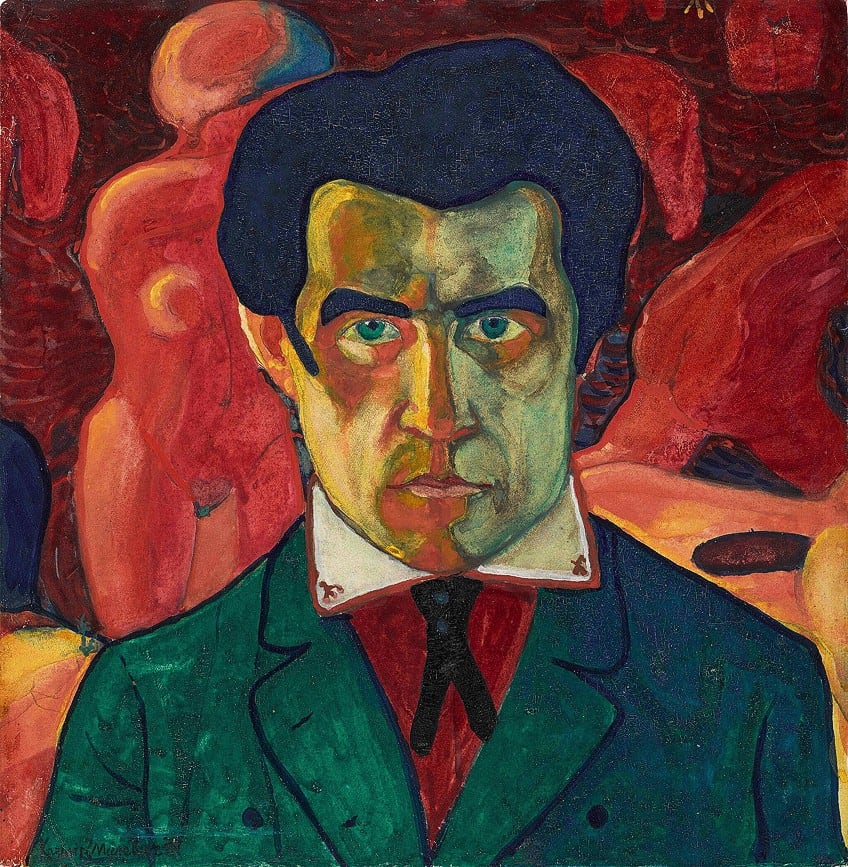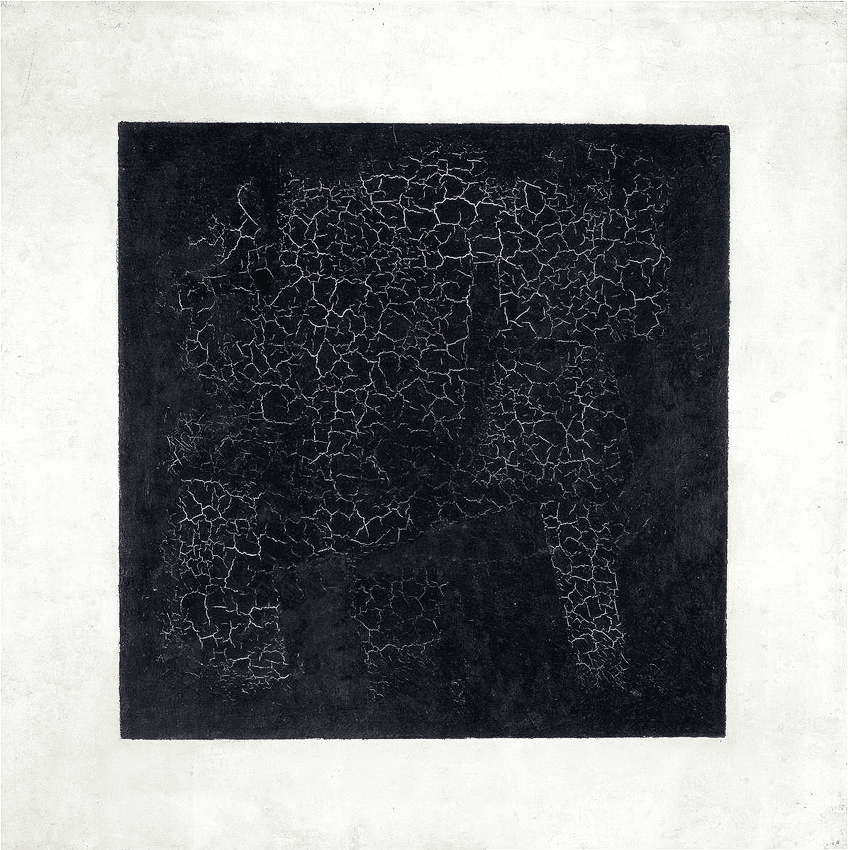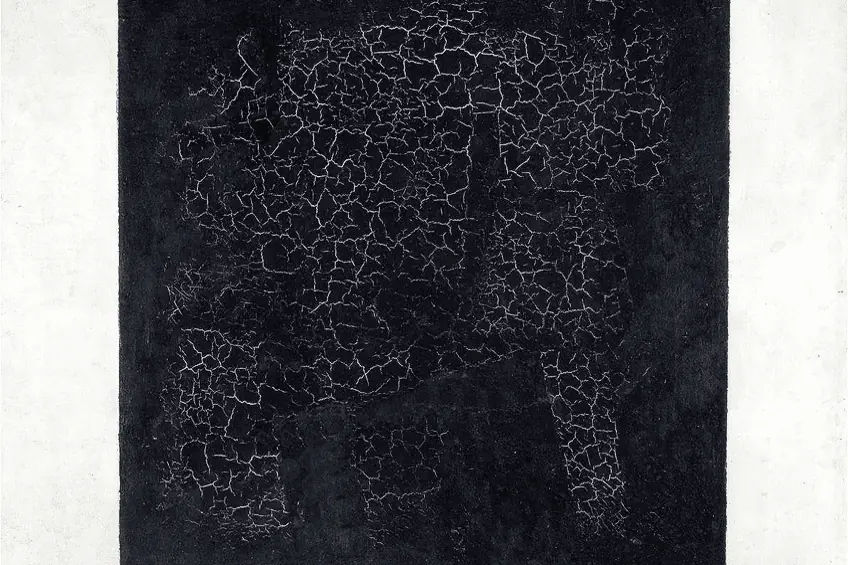“Black Square” by Kazimir Malevich – The Famous Square Painting
One would think that there surely cannot be that much to say about a black square painting that would fill an entire article. Yet, this famous square painting actually helped steer art in an entirely new direction. To find out why Black Square by Kazimir Malevich had such a significant impact on the world of art, read more below!
Contents
The Importance of the Black Square by Kazimir Malevich
| Artist | Kazimir Malevich (1879 – 1935) |
| Date Completed | 1915 |
| Dimensions (cm) | 79 x 79 |
| Medium | Oil on linen |
| Current Location | Tretyakov Gallery, Moscow, Russia |
Kazimir Malevich, a Polish-born Russian artist, took a medium-sized canvas, colored the edges white, and then covered the center with thick black paint. Malevich became the creator of The Black Square painting, one of the most significant artworks ever produced. With a simple flick of the wrist, he created the line that divides the worlds of traditional and contemporary art. To quote that artist’s own words, he wanted to reduce everything to “zero of form”.
For reasons unknown, zero ended up being a square, and this simple revelation represents one of the most massive shifts in art history.

The First Painting of Nothing
It is frequently regarded to be the first time that anyone produced a painting that didn’t portray anything, and Kazimir Malevich definitely thought so (but the debate continues). In 1915, in a handout for the initial exhibiting of the artwork in The Last Exhibition of Futurist Painting, he noted that there had been no efforts to make a painting without any attribute of actual life, up until that point.
Painting was the aesthetic aspect of something, but it was never new or an aim in itself.

He made it obvious that he intended to forego presenting reality altogether and instead create a new universe of forms and shapes. He asserted in his 1927 book The Non-Objective World that in 1913, anxious to rescue art from the lifeless weight of the actual world, he sought refuge in the shape of the square.
Beginnings as a Stage Curtain
Malevich created four different variations of the Black Square. Although the original version was dated 1913, many believe he painted it in 1915. Some say that he only claimed that he produced it earlier as he was thinking about his reputation as the father of abstraction. In any event, the square initially appeared in 1913 as a theatrical curtain design in Victory over the Sun, the futurist opera.
Malevich had been working on a manifesto with Aleksei Kruchenykh, the poet, and Mikhail Matyushin, the musician, that advocated for the rejection of rational thinking. They intended to destabilize Western society’s existing structures and hierarchies.

They presented Victory over the Sun with poet Velimier Khlebnikov, in which the actors attempted to abolish reason by seizing the sun and erasing time. Kruchenykh’s zaum – a new language of sounds with no meaning – was employed in the libretto. This triggered an idea in Malevich. Inspired by the creativity of his friend’s linguistic explorations, he constructed a new artistic language made entirely of shapes and colors at breakneck speed. He referred to this new visual language as Suprematism.
The Black Square Painting as a Revolutionary Symbol
Malevich dubbed his new abstract painting style suprematism. Suprematism in painting is all about the dominance of color and shape. By using basic geometric patterns and a restricted palette of colors, he was able to focus on the painting itself rather than being distracted by expressing a scene, terrain, or person.
The famous square painting is more than just the first painting in a new genre. It’s a completely different sort of art item than anything else anyone had ever seen. Malevich presented it as the start of a new age of art, starting at zero.

When Black Square by Kazimir Malevich was first shown, the globe was in turmoil. It was during the height of World War I, and there was still instability in the aftermath of the 1905 Russian Revolution, which erupted in 1917 into the Bolshevik rise and the October Revolution. The Black Square painting emerged at a period when Russian art audiences, accustomed to futurist and Cubist works, had never seen anything like it. Malevich’s creative revolution appears to mirror the social change that was taking place. Malevich intended the famous square painting to be a symbol of a new age rather than a portrayal of an actual entity.
An Artistic Icon
Malevich displayed the picture in December 1915 at the Last Exhibition of Futurist Painting. He was eager to show off his new concept of suprematism, so the Black Square painting was hung high on the wall across from the room’s corner. Though this location could mean nothing to the typical non-Russian spectator nowadays, it was the same hallowed area in a traditional Russian home where a Russian Orthodox icon of a saint would sit. The comparison was not lost on the residents of Petrograd.
Malevich sought to emphasize the famous square painting’s particular or spiritual importance, making it the main attraction of the show and the overarching symbol of his new style.

Kazimir Malevich’s moti or trademark was the Black Square. When he returned to realistic paintings (typically of peasants and laborers) in his later works, he signed a lot of them with a small black square. At his funeral, the car transporting his remains had a black square on the front, and mourners carried flags with black squares on them. Even a flag with a black square was hung over his suprematist-style coffin, and it was later used to mark his burial. The black square became an emblem of 20th-century art, not only Malevich’s aesthetic.
No Right Way to Be Seen
Malevich’s paintings vanished from public notice within months of his death in 1935, and Stalin’s state-sponsored social realism was embraced as the ‘official art’ of Soviet Russia. The Black Square did not appear again until the 1980s. It became an emblem that few could see, thus the notion of it became practically mythological, and it still inspires and challenges designers and artists today. Because the square is clearly a simple arrangement, working with it allows you to begin to perceive it in new ways or consider how very simple items might represent specific thoughts.
People thought the famous square painting was unusual when it first appeared, and they still think it is strange today.

There are no incorrect or right answers. It may be a portal into the night, or it might simply be a black form on a white canvas, which was Malevich’s intention. He set out to disprove the assumption that art must depict reality. It’s fascinating to consider how performing something basic or even mundane may occasionally be revolutionary. That, in any case, is what makes the Black Square painting so radical.
Historical Context
Many curators, art historians, and critics regard Black Square as a key work of contemporary art, as well as abstract painting in the Western painterly traditions in general. Malevich proclaimed the square to be an expression of Suprematism, an ideology he established but which is now almost solely identified with Malevich’s paintings and his student Lissitzky. The movement had a few followers among the Russian avant-garde, but it was eclipsed by its brother constructivism, whose manifesto aligned more closely with the ideological beliefs of the radical communist government in the Soviet Union’s early days.
Suprematism may be viewed as a transitional period in Russian art history, spanning the evolutionary gap between constructivism and futurism.

However, the greater and more general leap forward portrayed by the artwork is the move from representational to abstract painting – a challenging change with which Black Square painting has been connected and for the reason that it has become one of the primary symbols.
Malevich’s claim that the work of art had never been an end in itself seemed hard to substantiate. Malevich may have accomplished it most conspicuously, but to claim that his achievement was unique in human history is exaggerated. There had, of course, been many abstract black lines made in prehistoric art 60,000 years ago. Yet, his was the first work to make such a statement after centuries of trying to perfect realism in art. Malevich’s paintings marked the point at which art took a significant turn.
Frequently Asked Questions
Why Is Black Square by Kazimir Malevich So Important?
At first sight, it may seem ordinary, but its value resides in the way it defies established beliefs about representation and art. Malevich was a significant figure in the avant-garde movement in Russia, which aspired to escape the constraints of traditional art and pursue new forms of expression. He was trying to create a totally abstract artwork with Black Square, one that did not relate to any identifiable objects or shapes in the physical world.
What Style Were Malevich’s Paintings?
Kazimir Malevich was a pivotal figure in the early 20th-century Russian avant-garde movement. He is most recognized for his Suprematism painting style, which is distinguished by geometric shapes, bright colors, and an emphasis on abstract forms. Suprematism was a significant break from conventional representational painting, which tried to show familiar objects and settings from everyday life.
Jordan Anthony is a Cape Town-based film photographer, curator, and arts writer. She holds a Bachelor of Art in Fine Arts from the University of the Witwatersrand, Johannesburg, where she explored themes like healing, identity, dreams, and intuitive creation in her Contemporary art practice. Jordan has collaborated with various local art institutions, including the KZNSA Gallery in Durban, the Turbine Art Fair, and the Wits Art Museum. Her photography focuses on abstract color manipulations, portraiture, candid shots, and urban landscapes. She’s intrigued by philosophy, memory, and esotericism, drawing inspiration from Surrealism, Fluxus, and ancient civilizations, as well as childhood influences and found objects. Jordan is working for artfilemagazine since 2022 and writes blog posts about art history and photography.
Learn more about Jordan Anthony and about us.
Cite this Article
Jordan, Anthony, ““Black Square” by Kazimir Malevich – The Famous Square Painting.” artfilemagazine – Your Online Art Source. May 23, 2023. URL: https://artfilemagazine.com/black-square-by-kazimir-malevich/
Anthony, J. (2023, 23 May). “Black Square” by Kazimir Malevich – The Famous Square Painting. artfilemagazine – Your Online Art Source. https://artfilemagazine.com/black-square-by-kazimir-malevich/
Anthony, Jordan. ““Black Square” by Kazimir Malevich – The Famous Square Painting.” artfilemagazine – Your Online Art Source, May 23, 2023. https://artfilemagazine.com/black-square-by-kazimir-malevich/.



